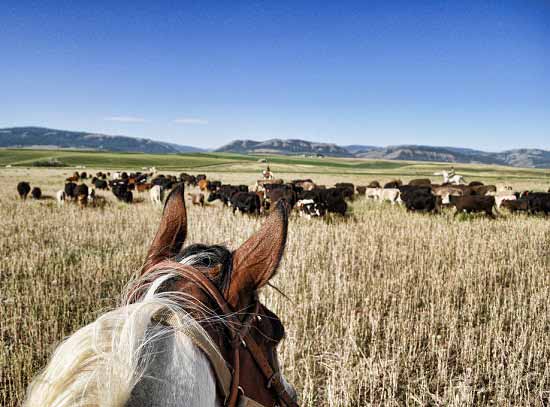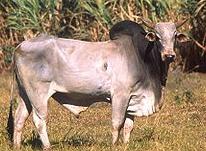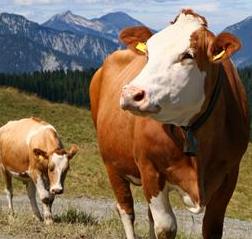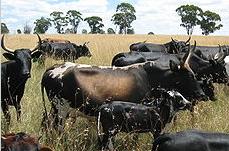Raising Beef Cattle
to Thrive in Your Pasture Rotation

Image Credit: Billy Gast
Cattle feed is by far the biggest expense when raising beef cattle. But pasture, whether in full bloom or frozen under a blanket of snow, is always significantly cheaper than even the cheapest cattle feed ration that money can buy. Thus, the key to lowering your grass-fed beef production costs is to learn how to raise cattle that you can keep on pasture for as long as possible throughout the year in order to minimize your cattle feeding expenses.
Grazing is easy during the summer when grass is lush and the weather is warm. The real skill as a grass-fed beef producer is to keep your cattle out on pasture during the other half of the year when the grass is no longer growing and the weather is no longer pleasant. That means you need to prepare both your pastures and your cattle.
Follow the link to the separate article to learn how to create tall high-quality pastures specifically tailored to winter grazing.
But just because you have the perfect pastures for a winter pasture rotation does not guarantee that you are raising beef cattle that are suited to winter grazing. You also need to prepare your herd for winter grazing.
In this article I will explain some key tips to ensure you are raising beef cattle that are suited to your grass-fed beef cattle management program. Since winter grazing is an integral part of managing your production costs this also means preparing your cattle for your winter pasture rotation so they can continue to graze safely long after the pasture grass has become dormant. I'll also show you why winter grazing a cow/calf herd only works if the cows are scheduled to calve during the growing season. And I'll discuss you how to pick the most efficient and well-adapted cattle for your grazing program.
Tip #1: The secret to successful winter grazing is BODY FAT carried over from the previous summer's growing season
Body fat stored during the summer months is the grass-fed beef producer's secret weapon to a successful winter grazing season. Beef production is about converting grass into beef at the lowest cost. Pasture is very cheap. But hay, silage, grain, and other cattle feed rations are expensive to grow, harvest, and feed. Body fat is the way that your cattle can store the cheap summer pasture so they can use it during the winter months to supplement their winter grazing.
Fatten your cattle as much as possible during the growing season so they can use their excess fat to supplement their winter grazing. This means your cattle fatten up during in the summer and then lose body fat in the winter, just like their wild grazing cousins.
This is where you might ask, "but if I am raising beef cattle year-round, isn't it more expensive to let cattle lose body fat during the winter because they have to be fattened back up again the following summer?"
When raising beef cattle, it is actually cheaper to let your cattle's body fat reserves fluctuate over the course of the year IF you plan to let your cattle rebuild their body fat again early in the growing season while cheap pasture grass is plentiful and growing very quickly. This means that the cattle regain the body fat very, very cheaply on pasture. As long as the body fat lost during the winter is within safe parameters, the excess body fat gained from the cheap pasture grass during the summer allows your cattle to make use of your winter pastures by supplementing themselves with fat off their backs.
To allow your cattle's body fat reserves to fluctuate within safe limits, we use a tool called Body Condition Scoring (BCS). It is a simple and systematic a way of visually assessing the body fat levels of your cattle. Follow the link to the article about Body Condition Scores, which explains:
- how to assess your cattle's body condition,
- identifies the safe range of body fat fluctuations when raising beef cattle,
- discusses how to use body condition scoring to improve the fertility of your breeding stock,
- and shows you how to use BCS as an essential tool to manage your winter grazing program.
Tip #2: Compensatory gain
Nature has another trick up her sleeve that helps you when you allow cattle to supplement themselves from the fat on their backs during the winter. It's called compensatory gain. Harness this powerful force and you will gain a massive unfair cost advantage over other producers who do not use this trick when raising beef cattle.
Cattle, like all animals, naturally slow their metabolisms to reduce their energy requirements when their nutrition is calorie-deficient. But once their metabolisms slow down, there is a considerable delay before their metabolisms speed up again once calories in their diets are increased again. During this period, cattle are able to gain weight with considerable efficiency, called compensatory gain. That's what makes this a free but extremely powerful tool to reduce your costs per pound of gain in your cattle herd.
You can learn more about how to use compensatory gain in your herd to increase cattle weight gains and reduce your overall cost of beef production in the article about compensatory gain.
Tip #3: Prepare cattle for winter grazing... by taking monthly forage analyses!
I've discussed how forage analyses are an important part of managing your winter pasture rotation in the articles about (1) winter grazing strategy and (2) body condition scores. But forage analyses are equally important for preparing your cattle for winter grazing.
Use your forage sampling program to create a database of how your pasture quality changes from month to month. Using this database, your livestock nutritionist can calculate exactly when to add nutritional supplements so you can control how quickly your cattle use up their body fat. This strategy ensures that you can prevent your cattle's body fat reserves from ever dropping below a Body Condition Score (BCS) of 5 during the winter.
Controlling the rate at which cattle use up their body fat reserves requires you to know:
- how much body fat each age group in your cattle herd has at the end of the growing season,
- and how much protein and energy is available from your pasture rotation during the winter grazing season.
Taking monthly forage analyses throughout the entire year, including during the growing season, allows your livestock nutritionist to calculate exactly how much body fat your cattle will have at the end of the growing season. This allows your livestock nutritionist to design a supplement program to control how quickly your cattle's fat reserves will be used up so that your cattle only reach a BCS of 5, just as the winter ends and the new growing season begins. Read these last two sentences sentences again - they are the secret to safely keeping your cattle grazing on pasture throughout the winter. This is how you minimize your production costs when raising beef cattle.
Monthly pasture forage analyses allow your livestock nutritionist to calculate exactly how prepared your cattle are for the winter grazing season and what supplements your cattle will need in order to continue your pasture rotation through the duration of the winter grazing season without risk to your cattle's health. Forage analyses give you precise control over your cattle's nutrition.
You can learn more about how to set up your forage analysis program in the "Planning for Winter Grazing" and the "Your Herd Nutrition Plan" chapters of Grass-fed Cattle.
Tip #4: Growing cattle need to continue to gain weight throughout the entire winter, even if only slightly, to maintain healthy bone and muscle growth:
Mature adult cattle will lose weight as their body fat reserves are drawn down. The weight of mature cattle will fluctuate by approximately 180 lbs between a body condition score (BCS) of 5 and a BCS of 7. That is a perfectly healthy weight fluctuation because their bone and muscle mass is not growing.
But growing cattle should not actually lose weight during the winter, only body fat. They still need sufficient nutrition for continued healthy bone and muscle growth. Again, this is where your forage analyses and your livestock nutritionist's calculations come together to ensure that you can control how much body fat the calves are allowed to lose during the winter without affecting bone and muscle growth.
Body fat during sexual development is directly correlated to your cattle's future fertility:
Letting your growing cattle reduce their body fat levels during the winter (down to a BCS of 5) is more than just about reducing your winter feed costs. Reduced body fat during the winter also ensures that your future breeding stock (heifer calves and intact bull calves) are able to develop their sexual organs without causing excess fat cells to be deposited in their sexual organs, which has devastating consequences to their fertility for the rest of their lives.
Too little body fat and your growing cattle risk their healthy bone and muscle growth. BUT, too much body fat during their adolescent sexual development causes permanent damage to their fertility and future milk production.
Too much body fat during your cattle's adolescent sexual development translates into:
- lower conception rates,
- higher replacement costs for your brood herd,
- and the future offspring from your overly fat heifer calves will have lower weight gains because of the effect that excess fat cells in the udder have on milk production.
And all that translates into higher production costs when raising beef cattle.
Your (1) skill at reading your cattle's body condition during your winter grazing program and (2) the supplement program designed by your livestock nutritionist will help you walk that fine line between too little and too much body fat in your growing young breeding stock.
Read the article about lifelong beef cattle fertility as well as "The Cattle Year on Grass" chapter of my book, Grass-Fed Cattle: how to produce and market natural beef, to learn more about how to maximize the future fertility and future milk production of your growing cattle by controlling their body fat levels during their adolescent sexual development.
Tip #5: Calving date determines whether your cow/calf herd is suited for winter grazing
If your program for raising beef cattle includes a cow/calf herd, then the calving date is another vital component of your strategy for raising beef cattle. Choosing the right calving date is a non-negotiable make-it or break-it component of your winter grazing strategy.
If you choose the wrong calving schedule for your cows and heifers then you cannot safely continue your pasture rotation through the winter without risking the health of your herd and without risking devastatingly low conception rates in your next breeding season.
Picking the right calving date for your cow/calf herd is extremely easy. The short and simple rule is: calve during the growing season, after the cows have had time to fatten up to a BCS of 7 on growing pasture.
When your herd calves during the growing season, you are mimicking the efficient time-tested calving schedule that Nature has chosen for all her wild grazing species. Wild grazing species, from the deer and moose in the Canadian prairie, to the antelope in the Texas high plains, and the wildebeest in the East African Serengeti, all time their calving seasons to start a few weeks after the beginning of the new growing season because this timing works so well.
Calving during the growing season stacks all of natures advantages in your herd's favor. Calving during the growing season:
- allows your cattle to safely participate in a winter grazing program,
- improves your herd's fertility and conception rates,
- gives your herd the advantage of experiencing compensatory gain at the start of the next growing season,
- reduces veterinary bills and health issues in your cattle herd,
- dramatically reduces calving problems and the need to assist cows during calving,
- dramatically increases calf survivability,
- significantly reduces disease pressure from diseases like scours, pneumonia, and coccidiosis that are the plague of most conventional calving schedules,
- and significantly reduces your overall beef production costs.
Calving date is the single most important choice you can make for your cow/calf herd because of the enormous impact it has on almost every single part of your beef cattle management strategy.
Your cow/calf herd MUST calve during the growing season to participate in a winter grazing program. Period.
The article about choosing the perfect calving date for raising beef cattle explains how to calculate the timing of your ideal calving season so that your herd's nutritional needs match up with the rising and falling nutritional quality of your pastures throughout the seasons.
I also recommend that you read "The Cattle Year on Grass" chapter of my book, Grass-fed Cattle: how to produce and market natural beef, to learn how to raise cattle that are in sync with the rising and falling nutritional quality of your pastures throughout the seasons. This chapter also explains how calving date and body condition at the time of calving affect fertility during the breeding season and even shows you the huge impact that photo-period (length of daylight during the breeding season) has on your cattle's fertility.
Tip #6: Use a 42-day breeding season
A 42-day cattle breeding season is another vital component of raising beef cattle so they are suited to winter grazing. A 42-day cattle breeding season is so important that it deserves its own full-page article.
Follow the link to the 42-day cattle breeding season article to learn how a 42-day breeding season improves your beef cattle management efficiency, reduces production costs, increases your herd fertility, helps extend your grazing season, and is crucial to your ability to use your herd as a management tool for preparing your pastures for winter grazing.
Tip #7: Choosing the perfect breed(s) for your grazing program:
Cattle breed choice is an extremely important consideration when raising beef cattle because it determines how well your cattle are adapted to your production environment, both during the summer and during your winter grazing program. The genetic adaptations that each breed has to different climates all around the world will help you choose the right beef cattle breed(s) for your unique situation.
There are three main considerations to remember during your breed selection:
- Climate and environment
- Desired slaughter weight and slaughter age
- Marketing strategy
Some breeds are more suited to cold weather than others. Some are better adapted to grazing through deep snow. Others are extremely heat tolerant or more resistant to certain types of parasites than others. Some finish lighter and younger than others. Some produce marbled beef (visible fat streaks within the meat), others do not. And the list goes on and on.
Before deciding on the herd genetics you will use for raising beef cattle, identify the environmental and climate conditions that your cattle will face on your farm. You also need clearly-defined goals that your cattle need to accomplish to suit your production strategy. Only then can you select the breed(s) with the right characteristics to match the conditions and goals of your beef production program.
Some of the questions you need to answer are:
- What kind of temperatures (hot and cold) will they face?
- What are the soils like in your pasture rotation (some breeds, especially those which developed in mountainous areas, are not able to keep their hooves worn down if they are not kept on hard, abrasive, rocky ground for at least part of the year, which is the trade off for having hooves that re-grow quickly to survive on abrasive soils).
- What kind of parasite loads will they face (i.e. tropical or temperate zone parasites)?
- How damp is your climate?
- What age (and weight) do you need your cattle to finish at in order to suit your production cycle and keep your production costs down? - are you raising beef cattle to be grass-finished for market before their second winter or can they carry on growing and gaining weight on your pastures until they reach 24 or even 36 months of age?
- Is there a price premium or a marketing advantage to one breed or another to take advantage of market opportunities in your area?
- How strong are the cows' mothering instincts? - important especially if they calve far away on a government grazing lease in the wilderness rather than in a tightly controlled pasture rotation!
It's important to take the time to learn about the history and climatic adaptations of each breed that you are considering before making your choice rather than 'falling in love' with a certain breed based on appearance or for sentimental reasons because your grandfather was raising beef cattle of that particular breed back in the Old Country.
Each cattle breed evolved to have an edge in the climatic conditions of it's ancestral origins. For example, Highland Cattle developed their shaggy hair coats to survive the cold winters and wet, rainy climate of the Scottish Highlands. Simmentals thrived in the high alpine regions of the Swiss Alps as a dual purpose breed producing both meat and milk. Beefmaster Cattle combined the heat tolerance and parasite resistance of the tropically adapted Brahman Cattle with the milk production and hardiness of Shorthorns and the longevity, docile nature, and hardiness of Herefords.
In other words, despite the strong opinions within the cattle industry about one breed or another, in reality there is no such thing as the perfect breed, only the perfect breed or breed combination to suit your farm's climate and unique market opportunities.
There are literally hundreds of cattle breeds and even more crossbreeding options to choose from when raising beef cattle. Your job is to pick the right breed or breed combination to match the production strategy, market opportunities, and climatic conditions of your individual farm.
Follow the link to the article about how to choose the right breed(s) to suit your grazing program to learn:
- How to determine which breeds will thrive in your climate.
- What genetic characteristics to look for to help your cattle overcome the environmental challenges on your farm.
- How breed choice affects heat and cold tolerance, parasite resistance, finishing weight, and the length of time required to grass-finish before your cattle are ready for slaughter.
- Whether a purebred, cross-bred, or mixed breed herd is right for raising beef cattle in your production and marketing program.
And dig even deeper by exploring the "Genetics and Breeding: Selecting the Right Animals for your Herd" chapter of my book, Grass-Fed Cattle: how to produce and market natural beef, to learn how to select the right breed to suit your climate, environmental conditions, and market opportunities. This chapter will also teach you how to recognize the physical characteristics of the most fertile, most efficient, lowest maintenance cattle regardless of what breed they belong to.
When you're ready to begin searching for the specific cattle breed or breed combination that's right for your ranch, check out the breed directories listed on my Cattle Links page.
Tip #8: Selection and Culling - choosing individual cattle for your grass-fed beef herd:
Genetic selection is a two-part process - (1) overall breed choice, discussed above, and (2) the individual cattle that you choose from within the breed(s) that you select for your grazing program.
Your choice of breed(s) is important to ensure you are raising beef cattle that are adapted to your climate and environmental conditions and to ensure that your cattle's finishing weight and finishing age suits your beef production and marketing strategy. But your choice of individual animals to include in your cattle breeding herd is of equal or even greater importance to your herd's ability to thrive in your grazing program. You need to learn how to pick the most fertile and most efficient individuals from within your breed(s).
The genetic variation within a breed is as great as the genetic variation between breeds. Including lousy individual cattle will do as much damage, or more, to your herd than picking the wrong breed. You need to train your eye to identify the characteristics that reveal the most fertile, lowest-maintenance (most efficient) individuals in order to maximize your conception rates, extend your grazing season, and minimize your production costs.
While tropical parasite resistance or environmental adaptations are extremely breed-specific, luckily the characteristics that define fertility and maintenance efficiency tend to be universal to all breeds rather than being breed specific. The characteristics used to identify the most fertile and efficient Nelore bull or cow will be virtually identical to the characteristics used to identify the most fertile and efficient Devon bull or cow despite the fact that their physical traits related to frame size, finishing weight, adaptation to temperature, and their parasite resistance will be extremely different.
Selecting the most fertile and most efficient cattle for your breeding herd is a two-pronged strategy based on:
selecting breeding stock that display a package of physical characteristics, which are indicative of high fertility and maintenance efficiency,
and using a strict culling program to remove any animals that fail to perform well in your production system:
Failure to conceive during a 42-day breeding season = automatic cull
Failure to calve unassisted = automatic cull
Failure to produce a high-quality live calf at the weaning date = automatic cull (baring exceptional circumstances)
Monitoring Body Condition Scores during the winter grazing season and aggressively culling high-maintenance individuals from within each age group.
To learn more about selection and culling practices that ensure you only include the most fertile and most efficient individuals in your cattle herd and that you are raising beef cattle with continually-improving genetics, explore the article on Selection and Culling: picking the right genetics for your grazing program. And you will find even more detail about selection and culling criteria in the "Genetics and Breeding: Selecting the Right Animals for Your Herd" chapter of my book, Grass-Fed Cattle: how to produce and market natural beef.
Related Articles:
(Disclosure: I get commissions for purchases made using Amazon links in my post.) And when you're ready to start planning your cattle farm, check out my book: Grass-Fed Cattle: How to Produce and Market Natural Beef. Use the links below to explore my book and read reviews on Amazon: 
|







